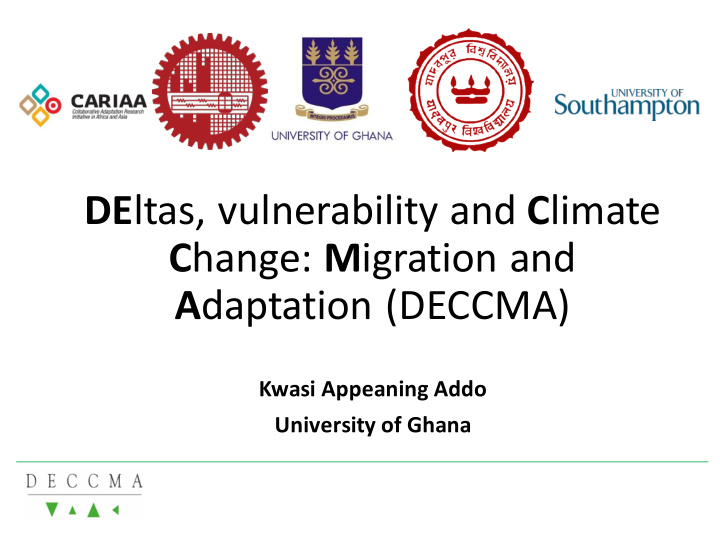



DE ltas, vulnerability and C limate C hange: M igration and A daptation (DECCMA) Kwasi Appeaning Addo University of Ghana
Other delta issues Taking Bangladesh as an example
Threatened deltas With Sea-level Rise and Subsidence Nile and Ganges-Brahmaputra Deltas (Broadus et al., 1986); Milliman et al ., 1989) People displaced by 2100 (2012 population): 16 to 20 million (Egypt) 42 to 54 million (Bangladesh)e
River Floods/ Sediment Supply Sedimentation, Climate Tectonics, Variability Subsidence, NATURAL Cyclones/ PROCESSES The Royal Senchi, 2-5 July 2017 Marine Processes
HUMAN ‘PROCESSES’ River Floods/ Sediment Supply Changing catchment management Sedimentation, ‘Global Climate Tectonics, Climate Variability Subsidence, Change’ Fundamental Population and Economic Change NATURAL Cyclones/ PROCESSES The Royal Senchi, 2-5 July 2017 Marine Processes
Key DELTA characteristics • Complex systems with large vulnerable populations • Multiple drivers operating at multiple scales • Rapid change, including significant migration • Vulnerable (but often lack political representation – so not an automatic focus for policy) • Climate change is an additional driver in this dynamic context
Study DOMAINS • Volta delta, Ghana • Ganges-Brahmaputra delta, Bangladesh/India • Mahanadi delta, India
Aims DE ltas, Vulnerability and C limate C hange: M igration and A daptation ( DECCMA ) 1. to evaluate the effectiveness of adaptation options in deltas 2. to assess migration as an adaptation in deltaic environments under a changing climate; 3. to deliver policy support on sustainable gender- sensitive adaptation in deltaic areas.
Objectives 1. to understand the governance mechanisms that promote or hinder migration of men and women in deltas; 2. to identify climate change impact hotspots in deltas where vulnerability will grow and adaptation will be needed; 3. to understand the conditions that promote migration and its outcomes, as well as gender-specific adaptation options for trapped populations, via surveys; 4. to understand how climate-change-driven global and national macro- economic processes impact on migration of men and women in deltas; 5. to produce an integrated systems -based bio-physical and socio-economic model to investigate potential future migration under climate change; 6. to conceptualise and evaluate migration within a wide suite of potential adaptation options at both the household and delta level; 7. to identify feasible and desirable adaptation options and support implementation of stakeholder-led gender-sensitive adaptation policy choices.
DECCMA Work package STRUCTURE WP0 Management
Consortium Building a functioning, multidisciplinary, international consortium – Southampton January 2017. Four lead institutions with sub-contractors • University of Southampton, UK Bangladesh • University of Engineering and Technology (BUET), Bangladesh • Jadavpur University, India University of Ghana, • Ghana
Highlights Continued engagement with stakeholders at multiple levels, who have been involved in: • Identifying barriers to implementation of policies • Identification of adaptation options that are being implemented • Validation of climate hazards experienced
Highlights Vulnerability hazard mapping of deltas to identify the areas most at risk from environmental change. Cross referenced with results from household surveys to assess correlation between vulnerability and migration levels
Highlights Land Cover Maps for each delta using high resolution satellite imagery Constructed for two time periods so change in land cover can be analysed.
Highlights Household Survey completed for ~6000 (across all deltas) households in identified ‘sending’ areas to investigate: - Views on migration - Economic considerations - “Push & Pull” factors - Household structure - Remittances - Autonomous Adaptation
Highlights • 0.3% of respondents said environmental factors were the primary cause of migration. • The analysis shows that while only a small proportion of households perceive environmental risks as the principal reason for migration, perceptions of insecurity caused by environmental factors directly correlate with observed migration behaviour. • Individual perceptions of environmental risk and general wellbeing are central to how individuals respond to adversities
Highlights What type of environmental event impacts on the economic security of migrant households? 100 80 % of household heads 60 40 20 0 Flooding Drought Erosion Salinity Storm surges Cyclone Ghana Bangladesh Mahanadi Flooding and drought are more prevalent across the three sites • Erosion and occurrence of cyclones are recurrent forms of environmental impact in • Bangladesh and the Mahanadi (India)
Highlights Identification of the 19.7% Services 24.6% delta’s significance in national economies 20.2% Trade-Transport 19.3% using downscaled Input 11.1% Output Tables. Construction 14.6% 19.8% Industry 13.5% Graph shows Volta delta 7.4% and non-delta split. Fishing 1.7% 21.9% Agriculture 26.3% 0.0% 5.0% 10.0%15.0%20.0%25.0%30.0% Delta Non-Delta
Highlights Inventories of adaptation practices released. 122 documented examples of observed adaptations from DECCMA's four study sites. Of these, 93 relate to the Ganges Brahmaputra Meghna delta (85 from Bangladesh and 8 from the Indian Bengal Delta), 14 refer to the Mahanadi Delta (India), and 15 to the Volta Delta (Ghana)
Highlights Engagement in reviewing policy - Invited to give comments on the draft version of Odisha (India) State Climate Change Action Plan (2015-2020). - Invited to give comments on Ghana’s coastal development authority bill.
Key Message Male migration in the Volta delta leads to high numbers of female headed households (40%) What are the policy implications of this?
Coming soon! We are finding that migration is linked indirectly, rather than directly to environmental change and communities do not always perceive these links. Further detailed analysis of sending area survey will dig deeper into these links.
Coming soon! Implementation of ‘Receiving Area Survey’ to understand how successful migration has been.
Conclusion The analysis will guide sustainable and equitable development of deltas and will: • identify gender-differentiated stakeholder-relevant scenarios of local/regional/delta level vulnerability to climate change; • identify options for effective climate adaptation by the poorest groups in deltas; and • lead to the formulation of gender-sensitive adaptation funding proposals in the four study sites.
This work was carried out under the Collaborative Adaptation Research Initiative in Africa and Asia (CARIAA), with financial support from the UK Thank you! Government’s Department for International Development (DFiD) and the International Development Research Centre (IDRC), Canada. The views expressed in this work are those of the creators and do no necessarily represent those of DFiDand IDRC or its Board of Governors. Website: www.deccma.com Twitter: @deccma
Recommend
More recommend